Disclosure: Meeple Mountain received a free copy of this product in exchange for an honest, unbiased review. This review is not intended to be an endorsement.
From the BGG description of Walking in Burano, “Burano is a beautiful island of Venice in Italy, known for its colorful houses. Walking through the island, you will see these vibrant houses on both sides of the canal, as well as the personal décor placed by the inhabitants of these houses and shops. Tourists always linger on the street to appreciate and enjoy the view.”
The original Walking in Burano (WiB) was a card drafting game in which players took turns selecting a card, or set of cards, from a changing lineup of cards, and then using those cards to build the ever-present houses, attract the tourists, and please the locals for points.
Walking in Burano: Roll & Write (WiB:RW) reimagines the game in a new format. The drafting is still there, but the cards have been replaced with differently colored dice. Each die corresponds to a specific building and can be used to perform various actions. The strength of the selected action is based on the die’s value, and this value can be adjusted by spending coins, which can be acquired in a number of ways.
At the end of each drafting round, the players will have the opportunity to spend coins to invite one of the characters to come see what they’ve done. Each of these characters scores points for different things—having a lot of cats, for example. Once any player has assigned five characters, the end game is triggered and everyone gets an additional round. Then final scoring is performed to determine the winner.
Of course, this is a high-level overview of the game. If you’ve seen enough and just want to know what I think, feel free to skip ahead to the Thoughts section. Otherwise, read on as we learn how to play Walking in Burano: Roll & Write.
Setup
A game of WiB:RW is set up thusly:
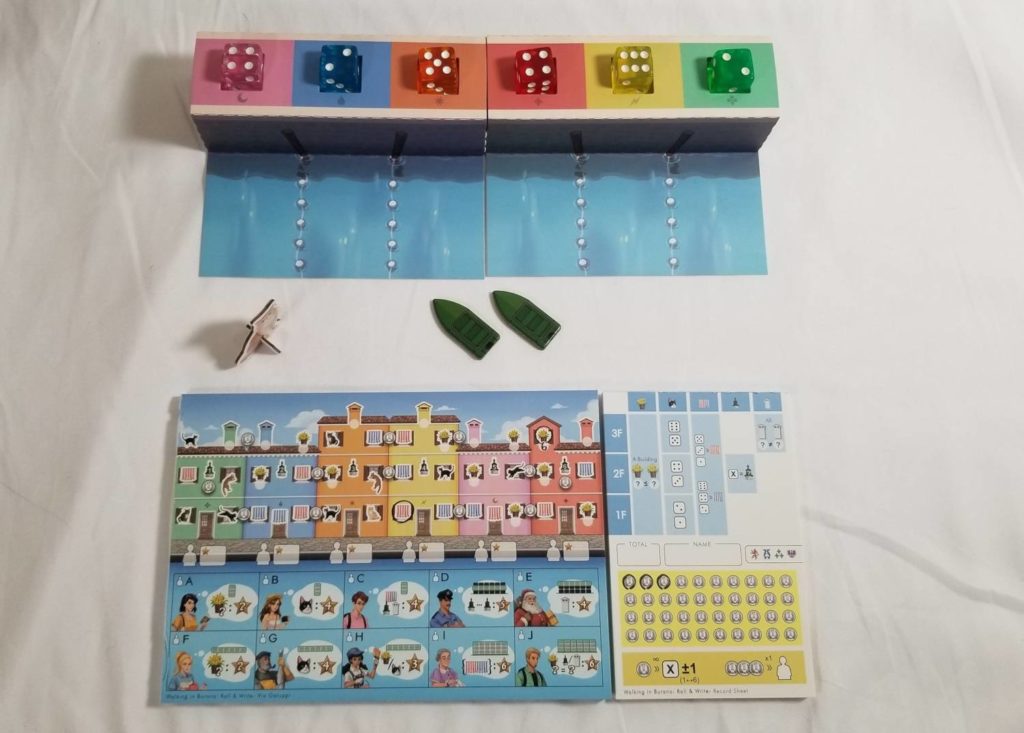
Each player receives a Record sheet, a Game sheet, and a writing utensil. After choosing a color, the players also receive the two boats of their chosen color. Then the two Dice Stands are placed side by side. Now, choose a start player (called the ‘Turn Player’ in the game’s vernacular) and give them the Turn Player marker (which is a standee of a cute little cat).
Now, you’re ready to begin.
Round Structure
The Turn Player rolls the dice and places each die into its matching Dice Stand without changing the die’s value. Then, starting with that player, each player places one of their boats onto one of the Dice Stand slips (which can only hold two boats each) and performs one of the available actions on the building matching the die’s color, using the value of the die to determine the strength of the performed action. The die’s value may be adjusted by spending coins (marking off coins that have been circled) at a 1 pip/1 coin rate. Sixes can be rolled over to ones and vice versa. We’ll go into more detail about the actions shortly.

A player may never place their boat on a Dice Stand where they already have their other boat. If a player places a boat on a slip where someone else already has a boat, that other person earns a coin (earned coins are circled on the Record sheet). Additionally, instead of performing the action, a player can flip their boat to its reverse side, take two coins, and ignore the action entirely.
Once each player has selected their first slip, in reverse turn order, the players select a second one and perform those actions as well. And, after the players have all performed their second action, players may opt to spend three coins to invite a character. Each character has a letter associated with it. If invited, the player writes the character’s letter into one of the character slots beneath one of their buildings. Players may opt to not invite a character and earn a coin instead. We’ll go into more detail about how the characters score later.
Then the Turn Player marker is passed to the next player in clockwise order and a new round begins.
The Actions
Each building has a collection of different features. The features present on a specific building determine which actions can be performed on the building. When you choose to use a feature, you’ll circle it on your sheet to show that it’s been used. The following is a list of those features and how you’ll interact with them.
Potted plants: Each plant has a blank circle associated with it. This circle can accommodate any number (the pip value of whatever die you use). There is a catch, though. If a house has multiple potted plants, each new potted plant must have a value equal to or lesser than the lowest previously written value on any of the other plants.
Curtains: There are two types of curtains, red and blue. Odd values are used to circle red curtains. Even values are used to circle blue.
Cats: Cats live on different floors of the dwellings. The value of the die you use determines which cats can be circled. Ones and twos are for cats on the first floor. Threes and fours are for cats on the second. Fives and sixes are for the third floor/roof.
Chimneys: Each chimney can accommodate any value. However, each chimney must have a value different from any other chimney.
Street lamps: Each house has a numbered street lamp. In order to circle it, the chosen die must have a color that matches the house and a pip value that matches the printed number.
Some of these features have a coin icon next to them. Circling these features allows you to also collect a coin.
The Characters
There are ten different characters in the game. Each of them has some preference. There are several that score for the specific building they’re assigned to, several that score for a row of your choice, and several that look at the entire collection of buildings. These characters score for such things as having a lot of cats, having pairs of red and blue curtains, or—in the case of Santa Claus—how many chimneys you filled in.
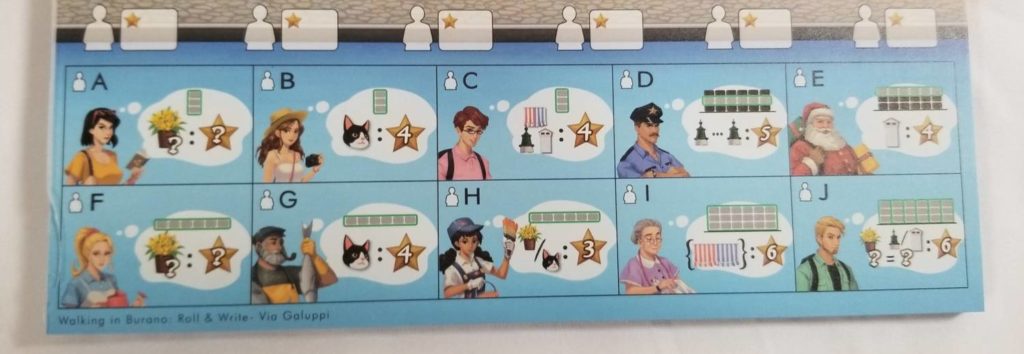
It is through the acquisition of at least five characters, by any player, that the game draws to an end. Once the end game is triggered, the current round is completed and the players play through one more. Then each invited character is assessed to determine their total. These totals are added together to determine the player’s final score. The player with the highest wins.
Thoughts
Full disclosure before I delve too far into these closing thoughts: I have never played Walking in Burano. So, unlike some reviews you may read, this is not going to be a side by side comparison of the two. Nor am I going to talk to you about how well Walking in Burano: Roll & Write captures the essence of its namesake, because I simply don’t know. Instead, I’m going to talk to you about this game specifically and my experiences with it thus far. And, for the most part, my experiences have been pretty positive. But there are a few rough edges I’d like to talk about first.
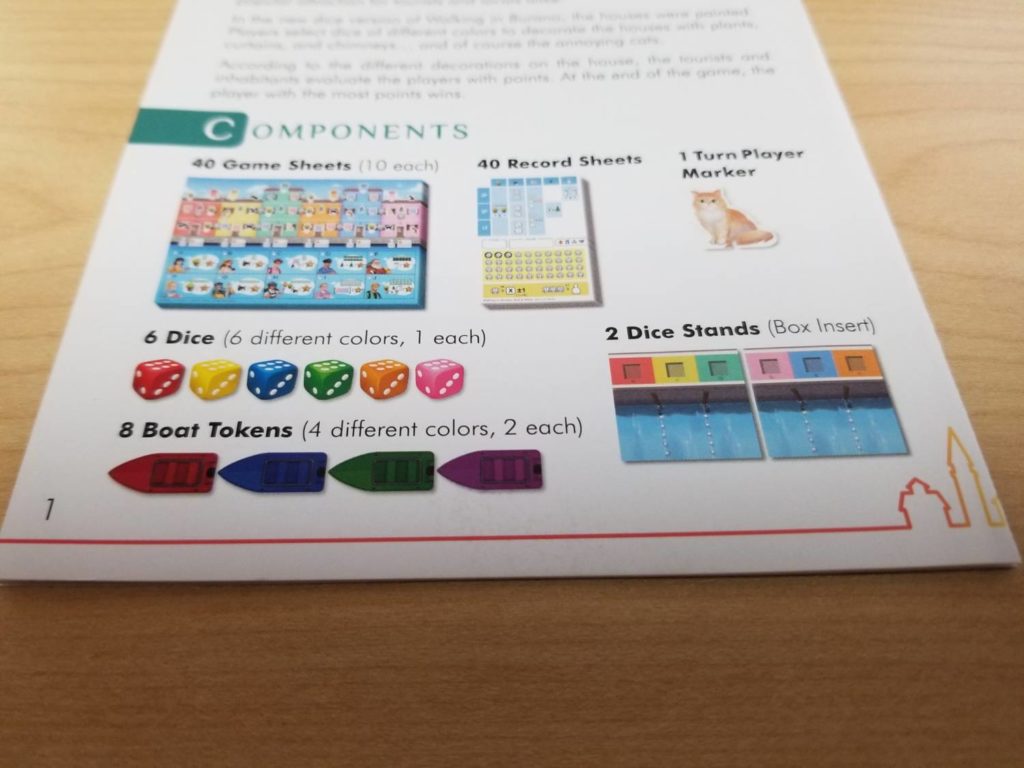
First up, you will notice from this image cribbed from the rulebook, the arrangement of the buildings on the Game sheets in the image do not correspond with the arrangement of colors on the Dice Stands. They almost match—the orange and pink Dice Stands are transposed—which is mildly irritating.
But what takes this mild irritation and turns it up to full blown maddening level is that the Game sheets provided in my game box do not correspond to either of these. The photos of what I should have do not match what I actually have. When you draft a die from the leftmost slip—which is red—for instance, your brain wants to look at the leftmost building on your Game sheet—which is green. It’s frustrating to have to train your brain to look in some entirely different spot, and this has caused consternation in virtually every single game of WiB:RW that I have played thus far.
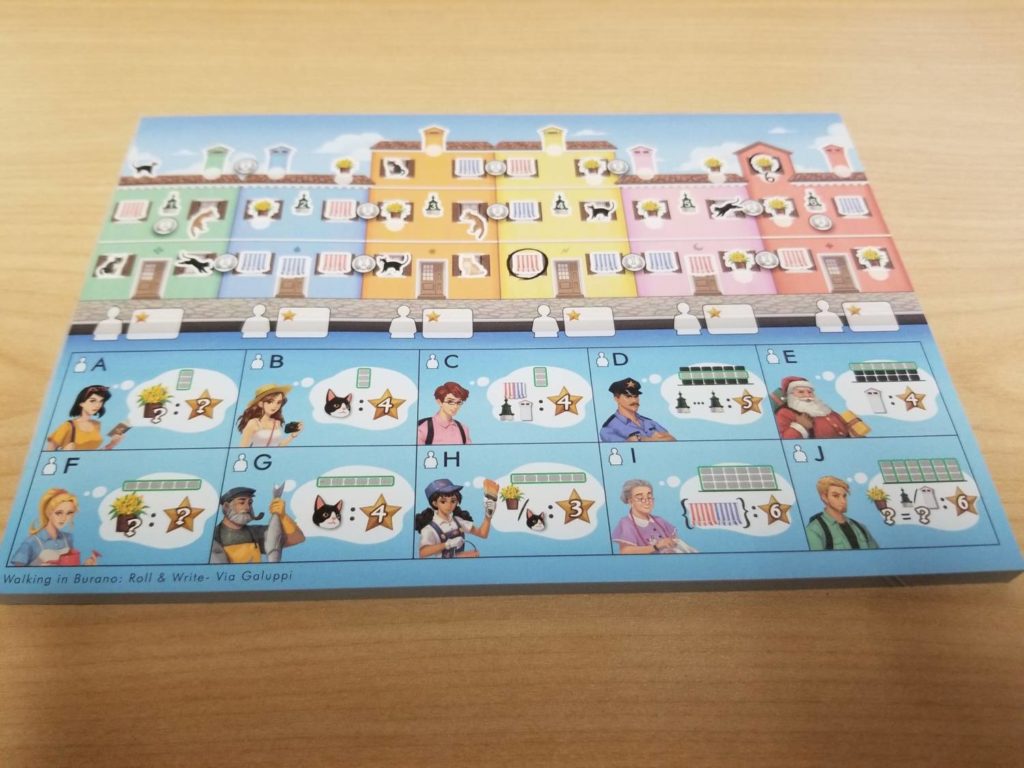
That’s my first complaint. My second is related to color-blindness. Now, some attempt has been made to make the game more accessible for players who experience this condition. Each Dice Stand has a symbol assigned to it and the buildings matching those colors on the Game sheets also have those symbols. So, you know that selecting a die from the Dice Stand with the lightning bolt icon will allow you to interact with the building that has a lightning bolt icon. That’s all fine and good and I applaud the publisher’s attempt. Where it falls short are the dice themselves.Take a look at this image which shows the normal colors in a side-by-side comparison to three different types of color blindness (made using an app called “Chromatic Vision Simulator”).
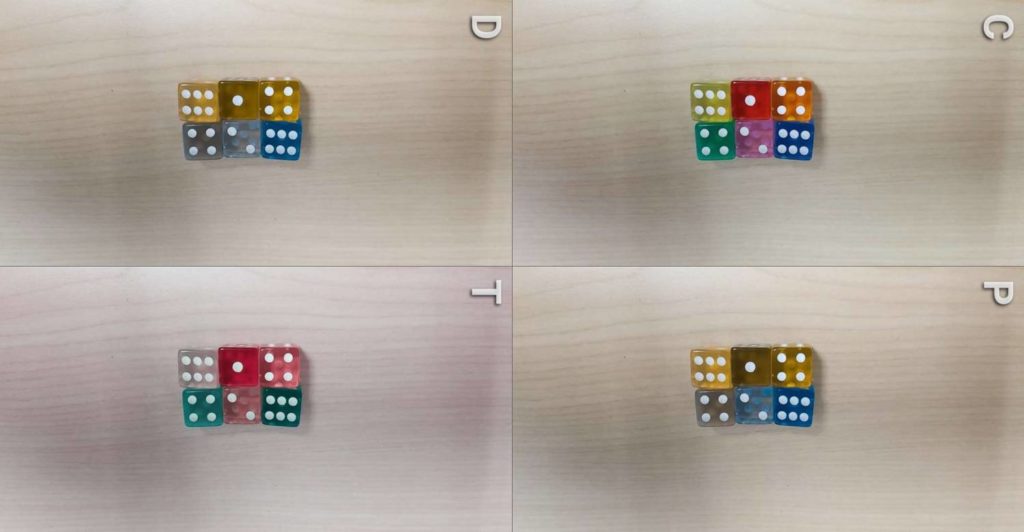
Can you see the issue? In each of the non-C images, the colors are almost indiscernible. This isn’t a problem if you’re playing with another person and they’re handling the task of placing the dice into their various Dice Stands. But, if you’re colorblind? Well, it looks like you’re out of luck. Since the color-representative iconography doesn’t appear on the dice themselves, there’s no way for you to know in which Dice Stands to actually place them.
Lastly, and this is a much smaller gripe, both the Game sheets and Record sheets are only single-sided. The paper is nice and thick, so it’s a mystery as to why the sheets aren’t double-sided. Double-sided sheets not only means more opportunities to play, but it also means less waste overall.
And that’s it for the negatives. Aside from the color and organization issues, I have nothing but praise for this very clever little game. At virtually every turn, you’ll find yourself assaulted with a variety of different options, and choosing the best of the bunch can be exceedingly difficult.
For instance, let’s talk about where all of your points come from: the characters.
The tricky part about inviting characters is that they score all of their points at the end of the game. Towards the end of the game, the decision of which characters to invite is easy. But those first few are hard to pick. If, for instance, you assign the girl that loves cats to a building early on, there’s no guarantee that the right combination of colors and numbers are going to come up to make that acquisition worth it. But, if you wait too long to invite characters because you want to see how things pan out, you might miss your opportunity entirely due to your opponents plowing ahead. So, there’s a degree of push-your-luck involved that’s not immediately apparent.
And then there’s deciding which die to draft when it comes around to your turn. Virtually any of them can work for you, but which choice is best? The characters you invite early in the game will largely drive these decisions. If you’ve invited Santa Claus, for instance, going for chimneys is a no-brainer. But other characters are not so obvious, or so easy to satisfy. And then there’s the consideration of whether or not to select a die someone else has already chosen. Choosing that option is going to reward your opponent with a coin. Is that something you really want to do?
And, speaking of coins, how should you even spend them? They’re a precious commodity in this game. The ability to use them to influence die values is immeasurably valuable. But each coin you spend makes it that much harder to invite a character later on. Is the tradeoff worth it? Or should you hold out and hope that the dice roll in your favor later on?
This is not to imply that WiB:RW is a super heavy game that’s going to pull your brain in a million directions. It isn’t. If you want something like that, then Hadrian’s Wall would be more your speed. If Hadrian’s Wall is a painful climb up the side of a steep mountain, WiB:RW is a pleasant stroll up a casual grade. Thematically, it’s more approachable. Mechanically, it’s a much easier game. And, horologically, it takes a fraction of the time.
So, if that sounds good to you, then you’ll definitely want to give this game a try. I’m certainly glad I did.


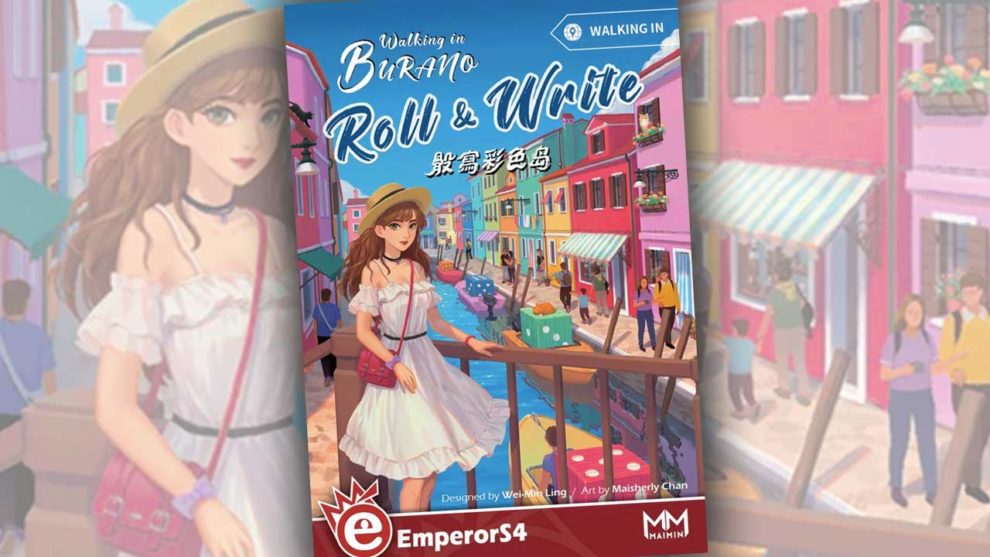








Add Comment